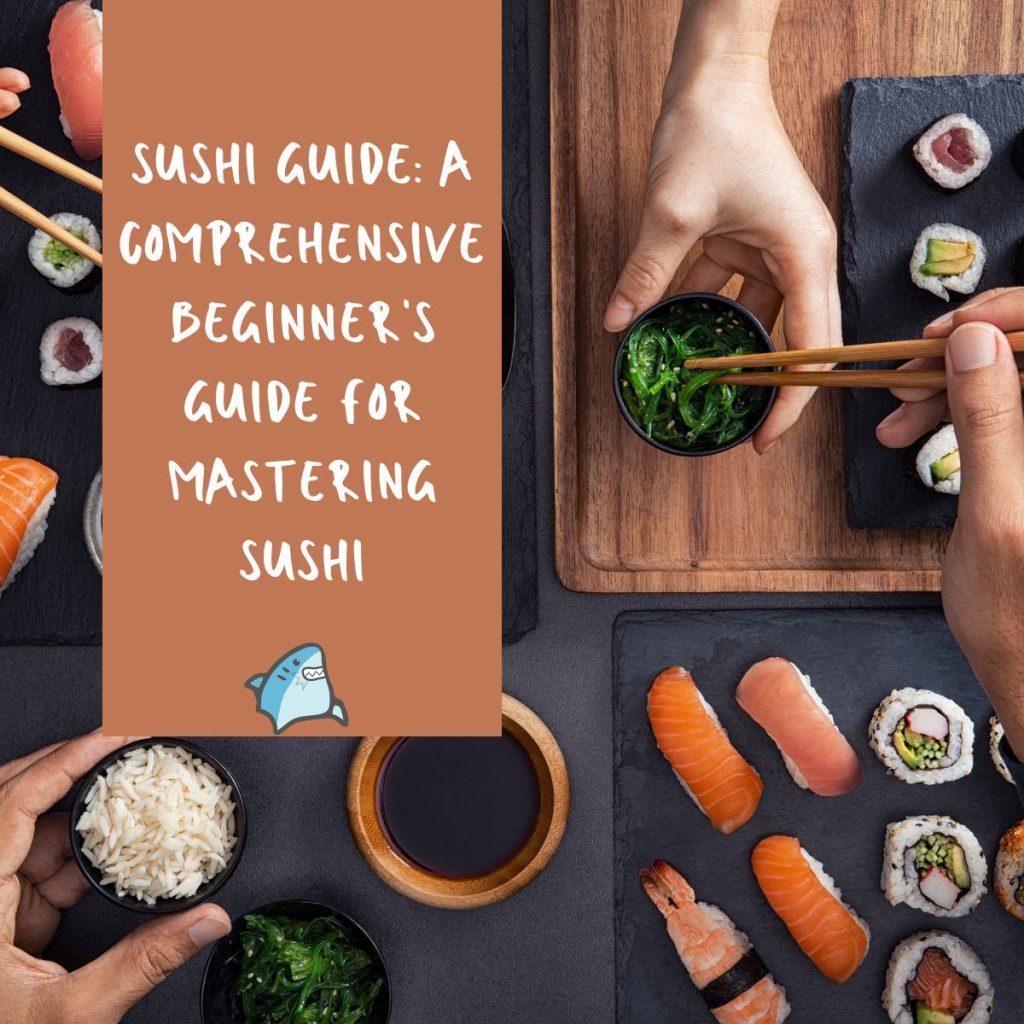Are you a sushi lover itching to up your sushi game? Look no further! This essential sushi guide has got you covered.
Get ready to dive deep into the world of sushi, from its origins to its various types and accompaniments. Discover expert tips on making sushi and mastering sushi etiquette.
Whether you’re a beginner or a seasoned enthusiast, this guide will equip you with the essential knowledge and skills to enjoy sushi like a true connoisseur.
Let’s get rolling!
Key Takeaways
- Sushi is a popular Japanese dish that originated in Southeast Asia and has evolved over time.
- There are various types of sushi, including maki rolls, nigiri, and sashimi.
- The ingredients used in sushi include sushi rice, assorted toppings, soy sauce, wasabi, and pickled ginger.
- When eating sushi, it is important to use proper etiquette, such as using your hands for certain types of sushi and not mixing wasabi and soy sauce together.

What is Sushi?
Allow me to guide you through the vibrant world of this beloved Japanese cuisine.
At its core, sushi is a dish often comprised of vinegared rice, accompanied by a variety of ingredients, frequently including tantalizing seafood.
However, sushi is not only about rice and seafood; it’s an art form, with a rich tradition and myriad of variations that set each sushi type apart.
Some may imagine sushi as a humble roll, served up in a sushi restaurant.
Yet, this is just one facet of it. Sushi can also come as a delicate slice of raw fish elegantly laid over a small mound of vinegary rice, or even be vegetables ensconced in a sushi roll.
Getting Your Sushi
Visiting sushi restaurants is a delightful way to explore all these variety, each dish a page in the vast sushi guide.
Ordering sushi can seem daunting. That’s why this comprehensive guide is a must – helping you navigate the ebbs and flows of sushi served around the world.
Ready to embark on this adventure? Say it with me now, “Irasshaimase, Sushi!”
The Origin
Let’s dive into the fascinating history of sushi, shall we? It’s a journey that takes us back hundreds of years, right into the heart of Japan.
Some interesting pieces of information to consider are how sushi wasn’t always the fine-dining experience we view it as today. Its origins stretch far back, with fish preserved in fermented rice.
It’s undoubtedly Japanese, no doubts about that. Now, let’s get more into sushi’s evolution. Initially, sushi wasn’t even about the fish! It was a method for preserving fish for months and sometimes even years.
Then, around 200 years ago, street food stalls in Japan introduced the kind of sushi we’re most acquainted with today.
These sushi restaurants offered a quick, tasty snack of fresh fish and vinegared rice, often eaten on the spot.
This sushi guide will explore this more in the sections to follow. Remember, there are many kinds of sushi to enjoy, broaden your horizon and enjoy every piece of sushi in your journey.
What Makes Sushi Popular?
Why is sushi so popular all the way from sushi restaurants in Japan to the rest of the world? Well, in this sushi guide, we dive into why this seafood marvel has won hearts globally.
The way sushi is served, bringing together fresh fish and other ingredients in a delicate balance, impacts its appeal.
You see, each sushi type from the traditional sushi roll wrapped in seaweed to less conventional versions stand out with their unique flavor and quality.
For sushi, every detail, like the right amount of soy sauce or the freshness of the fish, matters in creating delightful, memorable bites.
The rise of sushi restaurants worldwide has also fueled sushi’s popularity, allowing anyone to experience this tantalizing Japanese cuisine.
Sushi, with so many variations, has something to offer everyone and captivates our taste buds with its harmonious blend of textures and flavors.

The Sushi Basics: Exploring the Varieties
Let’s dive right into our sushi guide, where we’ll explore the basics of various sushi types, starting with the quintessential sushi roll.
Packed with fish, veggies, and rice, sushi can be a simple yet sophisticated meal. For beginners, the world of sushi may seem daunting, but once you get a taste, you’ll be hooked for life!
A sushi roll, also known as maki, is made by wrapping rice, fish or vegetables in nori, a type of seaweed.
Not a fan of fish? Vegetarian sushi options are also available, offering a versatile way to enjoy this dish. Then there’s the purest form: sashimi, raw fish served without rice. Each sushi type offers a unique taste and experience, allowing you to explore various flavor profiles.

1. Nigiri
This version of sushi, served as a strip of seafood over a compact handful of vinegar rice, remains a beloved classic. Did you know? ‘Nigiri’ translates to ‘gripped’ or ‘grasped’, and it’s a nod to the delicate craft that is sushi making.
It’s not as familiar as the sushi roll, but it’s just as pivotal. Here’s an interesting fact: Unlike the sushi roll, which is perfect for sharing, nigiri sushi has an individualistic flair. Each piece is a solo performance of flavor.
Now, keep in mind, sushi rolls come in many forms, and they’re widely popular. There’s no doubt they’re a satisfying introduction to sushi.
However, if you aspire to achieve a sushi master’s palate, make sure not to neglect nigiri sushi in your journey.

2. Sashimi
Now sashimi, a beloved staple in every sushi guide. Unlike sushi, sashimi is typically just raw seafood, a treat for true fish connoisseurs.
When we talk about seafood used in sashimi, we’re referring to an array of fish and shellfish, served raw of course! The beauty of sashimi lies in its simplicity, showcasing the natural flavors and textures of the seafood.
With sashimi, it’s all about the quality of the fish. When it’s can’t-get-any-fresher-than-this quality, you can truly taste the ocean.
Now, remember sushi? Well, sashimi, is an integral part of sushi culture.
It’s often enjoyed with a dab of wasabi and a dip into soy sauce.
Be warned, however, sashimi is not sushi. Sushi includes vinegared rice and can be paired with various ingredients, whereas sashimi is exclusively raw seafood.

3. Maki
It’s time to roll onto maki. Used frequently in sushi rolls, maki is a truly adaptable and delightful part of any sushi meal.
Perfectly rolled sushi, like maki rolls, provide a unified taste where every component holds an important role. As per maki tradition, a variety of fish, typically raw, is neatly enveloped inside the roll.
What sets maki apart? It’s all about the method. Unlike other forms of sushi, maki involves rolling ingredients in a bamboo mat to get that distinctive shape.
In other sushi roll types, the ingredients are often loosely strewn together. But the maki is tight, with every piece snug in its rice and seaweed wrapping.
Here are four key aspects of maki that you should know:
- Hosomaki: These are thin rolls consisting of only one ingredient, such as cucumber or tuna, rolled tightly with nori and rice.
- Chumaki: Medium rolls that contain two or three ingredients, offering a variety of flavors and textures in each bite.
- Futomaki: These thick and large rolls are filled with multiple ingredients, making them a satisfying meal on their own.
- Uramaki: Also known as inside-out rolls, uramaki have the rice on the outside and the nori on the inside, offering a different taste and texture experience.

4. Temaki
Temaki is a highlight in the world of sushi. Think of temaki as your fun, handheld sushi roll.
Different from other sushi types you’ve encountered in this sushi guide, this sushi roll is cone-shaped, with the nori on the outside wrapping around the rice and seafood within.
It’s not just the shape; the taste of temaki sushi is absolutely heavenly. You’ll find temaki sushi to be informal, making for a fun, interactive sushi experience.
The best part about temaki is that you can play around with your favorite seafood fillings. Can you imagine the explosion of flavor in each bite from that sushi? I can already sense your sushi cravings hitting their peak.

5. Inari
All the way to the 5th type we’re going to talk about is the delightful Inari. Now, what makes Inari a unique type of sushi? It’s a kind of sushi that’s a little different from your usual sushi roll. Let’s dive into it, shall we?
Inari is a sushi pocket made of fried tofu skin, filled all the way with sushi rice. The tofu is marinated in a sweet soy sauce, giving it a mellow, satisfying flavor.
Unlike with a typical sushi roll, you won’t find any fish in an Inari. Its simple nature allows the subtly sweet taste and the rice to take center stage, giving you a different yet equally delectable sushi experience.
Sushi, in all its forms, offers a way for anyone to enjoy it, and Inari is no exception.

6. Chirashi
Chirashi is a delicious and unique type of sushi that differs from a typical sushi roll.
Rather than being rolled up, this style of sushi is served in a bowl with a variety of seafood scattered over the top. It’s a delightful way to enjoy sushi, providing a different experience from a traditional sushi roll.
This sushi style showcases the seafood’s quality, served typically over a bed of sushi rice. Each bite gives way to a different taste, proving that sushi isn’t just about the roll.
As in every sushi dish, the quality of the seafood is essential—the fresher, the better. Whether you’re a sushi lover or new to sushi, trying Chirashi is an absolute must.


Konnichiwa! (Hello!) I'm Pat Tokuyama, a Japanese tofu cookbook author, who travels for music, food, and adventure. If you like Japanese tea, checkout some of the newestorganic japanese tea, matcha bowls and noren and more!
** Curious about the Plant Based Japanese Cooking Club? ** Learn more here!
7. Oshizushi
Often overlooked in the typical sushi roll party, Oshizushi is a truly unique form of sushi.
Rather than being the typical sushi roll you’re used to, Oshizushi, or pressed sushi, is piece of sushi art.
The sushi is served as rectangular or square pieces, meticulously pressed in a wooden mold.
The exquisite layers of rice and topping encapsulate every flavor profile sushi has to offer.
This sushi roll isn’t rolled at all! It’s a prime example of how diverse and intricate sushi can be.
So, next time you’re sitting at a sushi bar, go beyond the usual sushi roll and give Oshizushi a shot.
Best Sushi Rolls to Try for Beginners
As a beginner, navigating through the vast variety of sushi rolls can seem intimidating.
But fret not, this sushi guide is the perfect starting point for all sushi novices out there looking for a comprehensive understanding of sushi rolls.
So, let’s roll the sushi all the way! The sushi world of sushi rolls is an enticing playground full of tantalizing seafood wonders.
Each sushi roll brings its spectacular array of flavors ready to delight your palate.
The California Roll, with its crabmeat, avocado, and cucumber, is often recommended as the first sushi roll for beginners. It’s a great introduction to the wonderful world of sushi.
Or you may like to try a Philadelphia roll, which comes with smoked salmon, cream cheese, and cucumber. Don’t shy away from trying other sushi rolls too.

Ingredients for Making Sushi
Now we’re getting to the heart of sushi, the ingredients! Nothing captures the essence of sushi more than its ingredients. They’re truly the stars of the show.
To make delicious sushi at home, you’ll need a few essential ingredients. Here is a list of what you’ll need:
- Sushi rice: This short-grain rice is sticky and perfect for rolling sushi.
- Assorted toppings: Fish, vegetables, and roe are commonly used to add flavor and texture to your sushi.
- Soy sauce: This savory sauce adds a burst of umami to your sushi rolls.
- Wasabi: A small dab of this spicy green paste can add a kick of heat to your sushi.
The most essential ingredient in sushi is none other than sushi rice. You may think you’ve tasted rice before, but sushi rice is a game changer. Its short-grain stickiness holds sushi together, while its hint of sweetness complements other ingredients.
Did I mention sushi rice? I can’t stress enough its importance in sushi making. Sushi isn’t sushi without good sushi rice; it’s about balancing flavors and texture.
Don’t let the simplicity fool you. It’s why sushi rice is the ingredient that defines sushi. Every grain of sushi rice, when properly prepared, helps deliver that unforgettable sushi experience.
So, from nigiri to maki, from sashimi to chirashi, it all starts with high-quality sushi rice. Learning to master sushi rice is the key if you aim to master sushi.
Perfecting the Sushi Experience: Tips to Make Sushi As a Beginner
Making good sushi might seem daunting, but don’t worry, even a beginner can master the art of sushi roll making.
To perfect your sushi experience as a beginner, continue exploring the art of sushi-making with these helpful tips.
- Start by using the freshest ingredients available. Fresh fish, such as tuna or salmon, will enhance the flavor of your sushi.
- Make sure to master the art of sushi rice. The rice should be sticky, but not too mushy, and seasoned with vinegar, salt, and sugar.
- Additionally, practice your knife skills to ensure precise and uniform cuts for your sushi rolls.
- When rolling, use a bamboo mat for even pressure and tightness.
- Finally, presentation is key. Arrange your sushi rolls beautifully on a platter, garnish with colorful ingredients, and serve with soy sauce, wasabi, and pickled ginger.
Keep this sushi guide at hand as you navigate your sushi journey. One sushi roll at a time, we’ll become sushi connoisseurs together!

The Sushi Etiquettes: How to Eat Sushi As a Beginner
If you’re a beginner and have always wondered about the correct sushi etiquette, then this sushi guide is perfect for you. Starting with sushi rolls, they’re easy to eat, making them perfect for those who are new to this Japanese culinary delight.
Just pick it up with chopsticks and you’re good to go. Now there are various types of sushi rolls – some simple, others more adventurous.
As part of your sushi journey, don’t hold back from trying multiple sushi rolls until you discover what delights your palate the most. Moreover, consuming sushi isn’t just about the sushi rolls.
It also involves appreciating the delicate flavours of the sushi itself. Bear in mind, sushi is not just about the taste, but also the experience. It’s okay to use fingers if chopsticks seem too tricky.
Most importantly, enjoy every bite—this isn’t a race!

What Foods and Sides to Serve With Sushi
Let’s talk about what foods and sides can be served with sushi to enhance the experience. A sushi roll, an iconic representation of sushi, is best enjoyed with accompanying sides such as pickled ginger, wasabi, and soy sauce.
Don’t be afraid to experiment with the accompanying goodies. How about another sushi roll? Or maybe, yet another sushi roll?
The point is, the variety of sushi rolls is vast and you’re well on your way to becoming a sushi roll connoisseur.
The sushi served is as important as how it’s served. Try to present your sushi attractively and eat it while it’s fresh.
And remember, sushi isn’t just a meal, it’s an exploration of flavors, textures, and a journey into Japanese culture. So, arm yourself with chopsticks, dive into our sushi guide, and embark on your sushi adventure!









Konnichiwa! (Hello!) I'm Pat Tokuyama, a Japanese tofu cookbook author, who travels for music, food, and adventure. If you like Japanese tea, checkout some of the newestorganic japanese tea, matcha bowls and noren and more!
** Curious about the Plant Based Japanese Cooking Club? ** Learn more here!